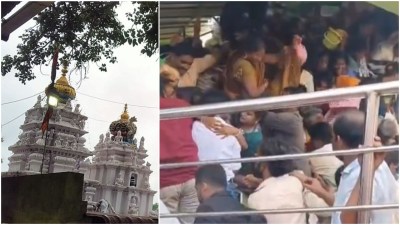Who is Yaroslav Hunka, Ukrainian Nazi praised in Canada’s Parliament?
Hunka received a standing ovation after he was called a hero on September 22. Later, it emerged that he used to be part of a Nazi military unit known as the 14th Waffen Grenadier Division of the SS organisation, which was involved in killing thousands of innocent people.
 Yaroslav Hunka, right, waits for the arrival of Ukrainian President Volodymyr Zelenskyy in the House of Commons in Ottawa, Onatario on Friday, September 22, 2023. (Patrick Doyle/The Canadian Press via AP)
Yaroslav Hunka, right, waits for the arrival of Ukrainian President Volodymyr Zelenskyy in the House of Commons in Ottawa, Onatario on Friday, September 22, 2023. (Patrick Doyle/The Canadian Press via AP) Speaker of the Canadian House of Commons Anthony Rota resigned from his post on Tuesday (September 26), just days after he praised a Ukrainian veteran who fought for a Nazi military unit during World War II.
Yaroslav Hunka, a 98-year-old, received a standing ovation in Canada’s Parliament after Rota called him a hero, who “fought for Ukrainian independence against the Russian aggressors then, and continues to support the troops today”. The event took place during the visit of Ukrainian President Volodymyr Zelensky on September 22.
In the following days, it emerged that Hunka used to be part of a Nazi military unit known as the 14th Waffen Grenadier Division of the SS organisation — the International Military Tribunal in Nuremberg in 1946 declared it a criminal organisation. Rota said he didn’t know about the Ukrainian veteran’s Nazi connections and made a mistake in inviting him to parliament.
So how did Hunka reach the Canadian parliament? Who is he? What was the Nazi military unit he served in? We explain.
Who is Yaroslav Hunka?
Hunka was born in interwar western Ukraine’s Urman village, Ternopil Oblast, in 1925, according to a University of Alberta newsletter, which announced an endowment in his name in 2020.
He volunteered to join the 14th Waffen SS unit soon after it was formed in 1943. Many of the details of his wartime involvement, however, remain unclear. After WWII ended, he settled in the United Kingdom, where he joined the Association of Ukrainians in Great Britain (AUGB) — the largest representative body for Ukrainians and those of Ukrainian descent in the UK.
Hunka married in 1951 and three years later emigrated to Canada with his wife in 1954, settling in Toronto, the newsletter said. He went on to earn a certification at a technical college and worked in the aircraft industry, rising to the position of inspector at DeHavilland Aircraft in Toronto.
After retirement, Hunka “devoted even more time to Ukrainian community life” and visited Ukraine frequently, the newsletter added.
What was Hunka’s Nazi military unit?
Hunka served with the Waffen-SS Galicia Division, also known as the SS 14th Waffen Division and as the First Ukrainian Division. Under the Nazi command, the unit mostly consisted of Ukrainian volunteers from Galicia, which stretched across parts of what is now southeastern Poland and western Ukraine.
“After the Soviet occupation of western Ukraine in 1939, the creation of the unit in 1943 attracted Ukrainians eager to fight for their independence,” Dominique Arel, the chair of Ukrainian studies at the University of Ottawa, told The New York Times.
“Being trained by SS officers, you can imagine the kind of political indoctrination they got,” he said. Despite their goal of attaining independence, Arel said the unit “fought for and were trained by Nazis. There’s no question about it.”
The military division was linked to the deaths of about a thousand innocent civilians, including jewish people, in Poland and Ukraine. It was believed to be responsible for the Pidkamin massacre on March 12, 1944, in which hundreds of Polish villagers were rounded up and killed, according to experts.
The unit suffered heavy casualties during the Soviet offensive against German-occupied Ukraine and Poland in 1944. Before it surrendered to the Western Allies in May 1945, it was renamed the First Ukrainian Division.
As mentioned before, Hunka’s role in the atrocities perpetrated by the division isn’t known.
Why does it matter?
The fresh controversy has once again highlighted decades-old allegations that the Canadian government has been quite lenient in prosecuting alleged Nazi war criminals or collaborators.
In 1950, Canada made special provisions for the entry of Ukrainians into the country after Britain asked for help managing an influx of soldiers who surrendered after the war, the CBS reported.
“These Ukrainians should be subject to special security screening, but should not be rejected on the grounds of their service in the German army,” the Canadian government announced at the time.
Authorities said the soldiers could enter Canada as they fought “not because of a love of the Germans but because of their hatred for the Russians and the Communist tyranny.”
As a result, more than 1,880 members of the 14th Waffen SS Volunteer Grenadier division immigrated to Canada in 1950, according to the Simon Wiesenthal Centre — a Jewish global human rights organisation.
The issue resurfaced in the 1980s, leading then-prime minister Brian Mulroney to order an investigation to determine if “Canada had become a haven for Nazi war criminals,” Canada-based CTV News reported.
“Charges of war crimes against members of the Galicia Division have never been substantiated,” said the final 1986 report from the Commission of Inquiry on War Criminals. “Further, in the absence of evidence of participation in or knowledge of specific war crimes, mere membership in the Galicia Division is insufficient to justify prosecution.”



- 01
- 02
- 03
- 04
- 05



































